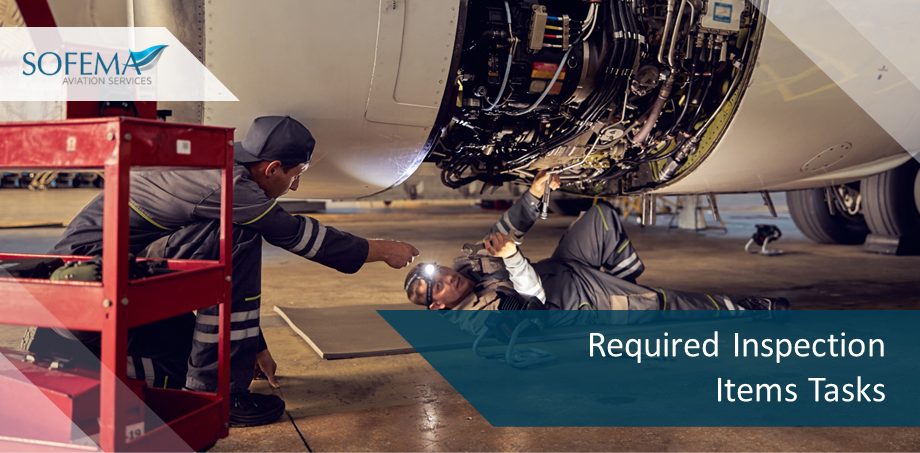Sofema Aviation Services (SAS) www.sassofia.com considers the role & purpose of Required Inspection Items (RII) Tasks
Introduction
- An FAA RII item is defined as a designation of the items of maintenance and alteration that must be inspected (required inspections) including at least those that could result in a failure, malfunction, or defect, endangering the safe operation of the aircraft if not performed properly or if improper parts or materials are used.
- Only Air Carrier authorized Repair Station Inspection personnel shall perform Required Inspection Items (RII) Inspections.
o Note: Procedures to ensure compliance with an air carrier’s or operator’s Continuous Airworthiness Maintenance Program (CAMP), including the separation of maintenance from inspection on those items identified by the air carrier/customer as Required Inspection Items (RII).
- Inspection Item (RII) must be inspected by a trained, qualified, and authorized Inspector. The Inspector must be listed on the Repair Station’s Inspection Roster and cannot be the same individual who performed the work. (Refer to part 121, § 121.371; part 125, § 125.251; and part 135, § 135.429 for details of this requirement.)
FAA Required Inspection Items (RII) Task Identification
FAA Required Inspection Items (RII) shall be identified in the (US) Operator’s Manual and must be accomplished by authorized personnel who are not involved in performing the work on the item to be inspected.
- The RII-qualified inspectors must work under the quality control system/inspection organization of the repair station.
- Under this subsection of the manual, the repair station will state how the separation between maintenance and inspection is managed.
- State that the AMO or the maintenance department of the air carrier cannot overrule the findings of the RII-qualified inspector.
- Include the organization’s procedures to ensure that any person performing RIIs is trained, qualified, and authorized by the air carrier for which the RII is being conducted.
Critical Task Inspection FAA versus EASA (Consider the Differences between FAA RII and EASA Critical Task Inspection?)
- Essentially the difference is that RII Inspectors are typically working under the “Quality Control Process” with the power to reject the work and insist on “rework”, whereas the EASA process is a less structured (but of course equally important).
Important note: EASA does not have a Quality Control Process Independent within the Production Process. However, make no mistake, both processes are of critical importance and must not be overlooked or subject to short-cut.
EASA Definitions (n) “critical maintenance task” means a maintenance task that involves the assembly or any disturbance of a system or any part on an aircraft, engine or propeller that, if an error occurred during its performance, could directly endanger the flight safety.
EASA Critical Task ref: AMC1 M.A.402(h) The following maintenance tasks should primarily be reviewed to assess their impact on safety:
(a) tasks that may affect the control of the aircraft, flight path and attitude, such as installation, rigging and adjustments of flight controls;
(b) aircraft stability control systems (autopilot, fuel transfer);
(c) tasks that may affect the propulsive force of the aircraft, including installation of aircraft engines, propellers and rotors; and
(d) overhaul, calibration or rigging of engines, propellers, transmissions and gearboxes.
What is the Critical Task Responsibility of the CAMO (Part M) & Part 145 Organisation?
- Part 145 is always responsible for its own process, regarding critical tasks and to implement an error capture method after the performance of any critical task.
- If the critical task is defined in the aircraft maintenance programme then the CAMO takes over some of the responsibility. The CAMO should ensure that the Part 145 organisation has both captured and understood what to do to ensure effective inspection of the critical tasks.
Summary of RII Requirements (MAG change 8)
Required Inspection Items (RII) Procedures
- State that RIIs identified in a U.S. operator’s manual must be accomplished by authorized personnel who are not involved in performing the work on the item to be inspected.
- The RII-qualified inspectors must work under the quality control system/inspection organization of the AMO.
- Under this subsection of the manual, the AMO will state how the separation between maintenance and inspection is managed.
- State that the AMO or the maintenance department of the air carrier cannot overrule the findings of the RII-qualified inspector.
- Include the organization’s procedures to ensure that any person performing RIIs is trained, qualified, and authorized by the air carrier for which the RII is being conducted.
Next Steps
Follow this link to our Library to find & Download related documents for Free.
Sofema Aviation Services (www.sassofia.com) and Sofema Online (www.sofemaonline.com) offer EASA Regulatory Compliant and Vocational Training across a range of Aviation Areas – please see our websites or email team@sassofia.com
Tags:
Aicraft Maintenance, Aircraft Repair, Airworthiness, CAMO, Compliance, Continuous Airworthiness Maintenance Program (CAMP), EASA, EASA Part 145, EASA Part M, FAA, Quality Control Process, Repair Station Inspection, Required Inspection Items (RII), RII Requirements, SAS blogs




